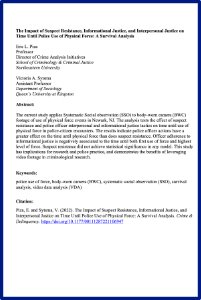By Jillian Long
Incidents of police-involved shootings resulting in the death of unarmed civilians, such as Andre Hill in 2020, Bijan Ghaisar in 2017, and Michael Brown in 2014, have raised concerns about law enforcement use of deadly force, particularly involving firearms. In light of these concerns, growing attention has been paid to less-than-lethal weapons (LLWs) and the role LLWs may play in providing law enforcement officers alternatives to the use of deadly force.
A multitude of weapons marketed as less-than-lethal alternatives to firearms are currently in use by federal, state, and local law enforcement, including batons, pepper sprays, and stun guns. There are also a number of LLWs in development, such as unmanned aircraft systems (drones) equipped with tear gas, rubber bullets, and TASERs.
Some observers contend that LLWs offer the possibility of minimizing risk of death and serious injury to citizens and officers while simultaneously providing law enforcement with effective tools to incapacitate violent or noncompliant persons. Nevertheless, there is evidence that LLWs may present a number of potential health risks, lending credence to arguments that LLWs are less-than-lethal in name, but, depending on the circumstances of their use, can be lethal in practice. For example, a team of journalists led by the Associated Press, in collaboration with the Howard Center for Investigative Journalism programs at the University of Maryland and Arizona State University, documented over 1,000 deaths that followed local and state police officers’ use of less-than-lethal force from 2012 to 2021. Similarly, a 2019 Reuters investigation of deaths related to law enforcement use of TASERs found that 1,081 individuals had died after being hit by a police TASER from 1983 to 2017.
Should policymakers consider examining ways to legislate on the use of LLWs, numerous issues may garner attention. Currently, there is no single, universally accepted definition of less-than-lethal weapon, and the use of the term varies greatly among U.S. federal, state, and local law enforcement agencies. Conceptualizing a definition for LLWs raises a number of questions, including whether LLWs should be defined
• under a label other than less-than-lethal,
• according to a common capability,
• according to a common operational utility,
• according to an intended use to minimize risk of death and permanent injury, or
• according to a common application.
Policymakers could consider whether it is beneficial to establish a statutory definition of less-than-lethal weapon. Codifying the meaning of LLWs could be useful in terms of clarifying what weapons are (and are not) classified as less-than-lethal, which may help sharpen the focus and potential efficacy of policies. On the other hand, some may argue that law enforcement agencies and departments are better suited to define LLWs and, thereby, address LLWs in their individualized use-of-force policies, based on their organization’s specific needs, duties, and circumstances.
Moreover, there are relatively little federal data available on law enforcement officers’ use of LLWs and, consequently, few studies analyzing the health effects caused by law enforcement’s use of such weapons. Policymakers may wish to direct a federal agency or department to conduct research into LLW injury and mortality. Based on these findings, policymakers could consider legislative actions to influence law enforcement use of LLWs, such as (1) passing a bill encouraging or limiting federal law enforcement officers’ usage of LLWs and (2) placing provisions on or withholding funding from existing federal grant programs to incentivize or discourage state and local law enforcement usage of LLWs.
R48365
Washington, DC: Congressional Research Service, January 23, 2025I
27p.





















